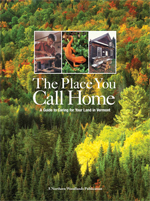 Northern Woodlands produces a set of booklets (magazine-style) called "The Place You Call Home" which they offer for free to residents of the regions for which the books are prepared (the Upper Connecticut Valley, the Catskills, and Vermont). The book is described as the owner's manual you should have gotten with your New England land, focusing on how you can keep it healthy and productive, in case you don't happen to be a forester.
Northern Woodlands produces a set of booklets (magazine-style) called "The Place You Call Home" which they offer for free to residents of the regions for which the books are prepared (the Upper Connecticut Valley, the Catskills, and Vermont). The book is described as the owner's manual you should have gotten with your New England land, focusing on how you can keep it healthy and productive, in case you don't happen to be a forester.Given my recent efforts at tending my land, this seemed like a great resource, especially as it's free for the asking. I've started reading it and am about halfway through it. I've learned a lot of interesting things. For instance, I can tell my land was probably always pasture but never cropland, and if I find a stone wall somewhere on it, the other side will probably be former cropland. I can tell which of the plants on my land are invasives, and which ones are providing food or shelter for various kinds of animals. I know the difference between swamps, marshes, bogs, fens, and vernal pools. I have a guide to what animals and plants are doing what things in each week of the year. I even know how much different kinds of woods probably sell for.
It's also inspired me to do a few things. I've added a field guide to identifying trees to my wish list. And I'm going to make more effort this coming year to walk more of my land and get to know it better, maybe even inventory what's on it.
However, what I was most hoping for was to learn what to do out there. And it's surprisingly skimpy on that. Everything is based on one assumption: you want to get a professional forester to come tell you. Which is probably true if you are part of their intended audience: people with 100 or more acres, mostly wooded. But so far they offer almost nothing by way of advice for those of us with 10 acres and less, which is a large and growing portion of the land-owning population in Vermont.
I can imagine that their goal of improving land management for the sake of wildlife and environment, and maintaining good lumber health, dictates a focus on the owners of larger parcels. Maybe despite how many people have 10 acres and less these days, we're still not yet worth them focusing their attention on. If so, that's a pity, especially for me with my 5.92 acres. But I really feel like there's room for a few pages for someone like me, someone whose land is still part of the fragmentation that can impact pollution and wildlife so much -- and so much more if it's not cared for with those things in mind -- but who can't possibly justify getting foresters and loggers involved when there's just not enough land there to pay them enough to make it worth their time.
I could try to get my neighbors involved and do this cooperatively, but even in the remote chance they all feel like doing this (I doubt it, most of them will probably take the tack of "I don't need no one to come in and tell me what to cut; the way my grandpappy did it is good enough") I am still not sure we'd have enough to make a real forest maintenance plan worth doing.
Maybe there will be more useful stuff later. And some of what I've learned is immediately useful. For instance, a few of the fallen trees I'd planned to cut up are now going to stay there -- now that I know what to look for, they seem more important as terrain and food for wildlife. I also know things to be aiming for -- for instance, I definitely need more understory, just don't know how to work towards having it (particularly not without giving up my screening from the road while it comes in).
Can't really complain about a free guide that's helpful not being as helpful as I hoped. Well, apparently I can, as I just did, but I probably shouldn't. Still, I wish they'd update it with a few pages for the thousands of people in my situation.

 RealTime and RTC
RealTime and RTC Prism
Prism Uncreated
Uncreated Bloodweavers
Bloodweavers Foulspawner's Legacy
Foulspawner's Legacy Lusternia
Lusternia
No comments:
Post a Comment